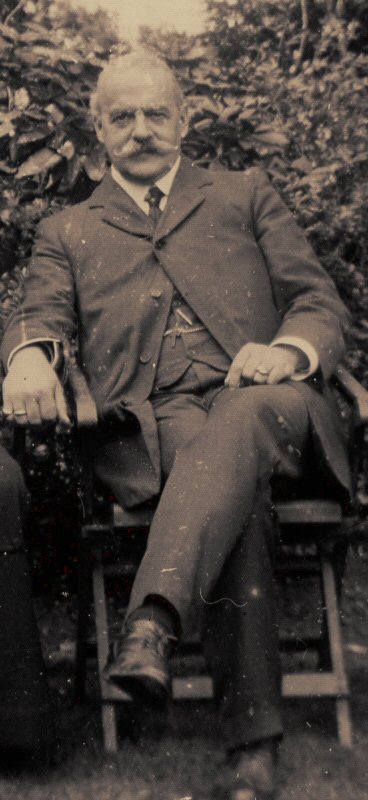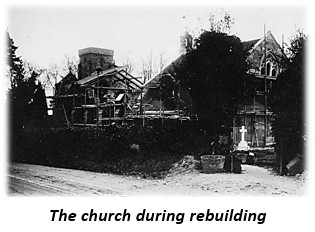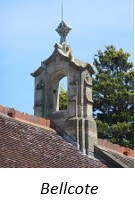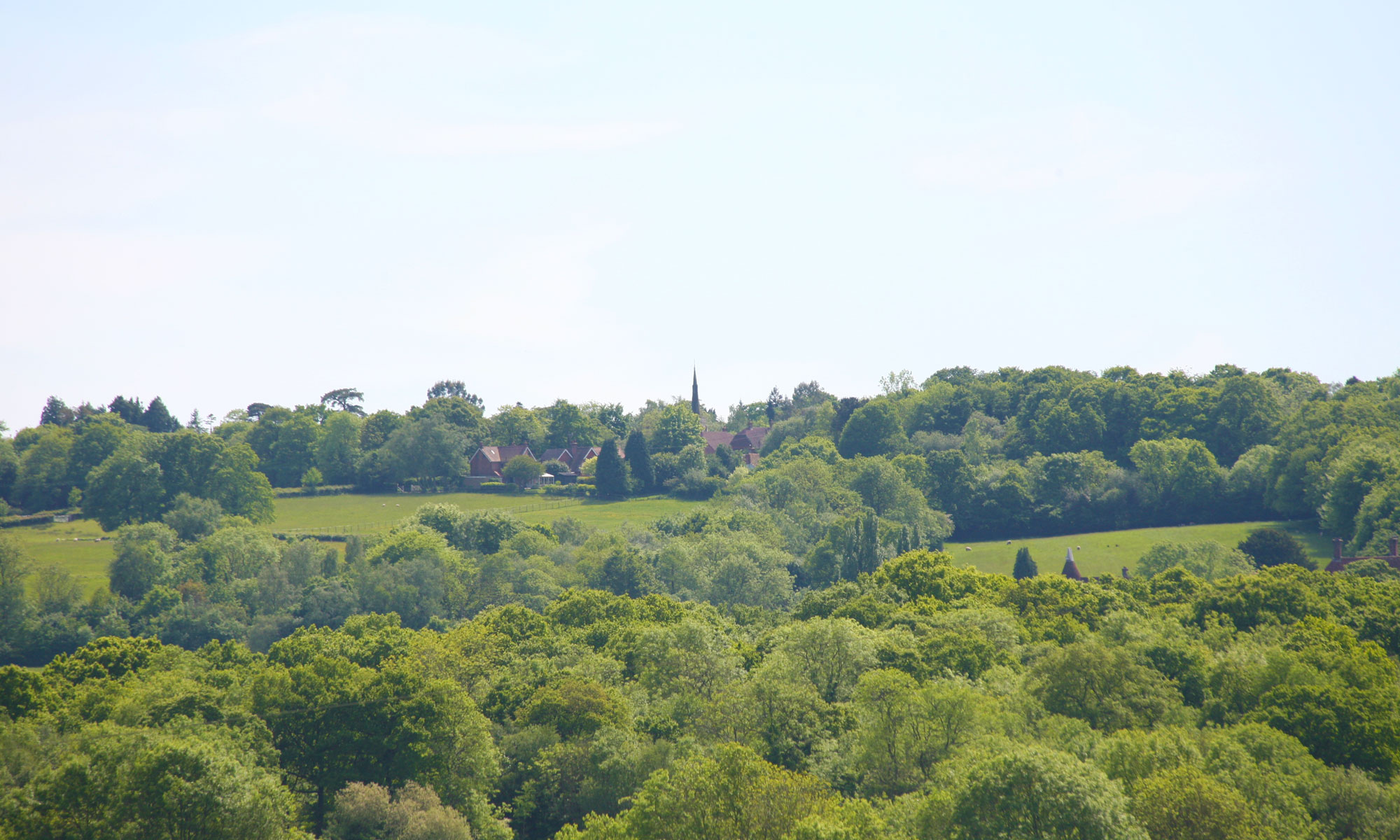 The Church of St. Mark the Evangelist provides an impressive first view of the village as you approach Hadlow Down from the West on the A272. The person responsible for its present day imposing appearance is George Halford Fellowes Prynne (1853–1927) a Victorian and Edwardian English church architect, part of the High Church School of Gothic Revival Architecture.
The Church of St. Mark the Evangelist provides an impressive first view of the village as you approach Hadlow Down from the West on the A272. The person responsible for its present day imposing appearance is George Halford Fellowes Prynne (1853–1927) a Victorian and Edwardian English church architect, part of the High Church School of Gothic Revival Architecture.
He was born on 2 April 1853 at Wyndham Square, Plymouth, Devon, the second son of the Rev. George Rundle Prynne and Emily Fellowes. His elder brother was the painter Edward Arthur Fellowes Prynne. He also had another brother, Albert Bernard (known as Bernard), and two sisters. His father was a well-known figure in religious circles of the time, being outspoken in his support of the revival of so-called high churchmanship in the Anglican Church and espousing the views of the Oxford Movement.
Very little information is available to give an idea of George Fellowes Prynne’s childhood. However, he cannot have failed to be influenced by his father’s constant striving and indomitable spirit. An impression of his life as a young man can be obtained from Prynne’s own notes. It is clear that architecture was not a profession that he had countenanced from an early age. Indeed, he spent some time studying privately with a tutor near Oxford with a view to becoming ordained, but, as he puts it ‘…difficulties arose as to the expense of a University education’.
George studied at St. Mary’s College, Harlow. He went on to Chardstock College, and thence to Eastman’s Royal Naval Academy at Southsea.
In 1871, aged 18, Prynne sailed to America to work with a cousin who had taken land, and was farming in the Western states. But, finding the work “trying and severe”, after almost two years he travelled to Toronto and got a job as a Junior Assistant in the office of architect Richard Cunningham Windyer eventually gaining a senior position there. George Fellowes Prynne takes up the story:
‘It was in these parts that one got one’s first experience in practical building, from log houses and barns, to a more respectable kind of brick and wooden house. It was here that I was initiated into the Mysteries of door and window-sash making – rough, but strong and practical.’
He first became interested in the study of architecture when his brother Edward was aiming to enter the office of George Edmund Street, R.A. Four years later, George Prynne had an offer of employment from the same architect. He was employed by Street for a year, later working with architects Swinfen Harris, R.J. Withers, Alfred Waterhouse and at the London School Board offices. He was a student at the Royal Academy between 1876 and 78. He commenced his independent practice in 1879 and became Architect to the Diocese of Oxford from 1913. Prynne set up in his own practice in 1880, stating that his first work “of importance” was the building of his father’s church, St. Peter’s, Plymouth. The sanctuary, which was already built, was by G. E. Street, and thus the link between the lives of Street and Fellowes Prynne continued.
Prynne designed many parish churches in England, mostly in the southeast and southwest, and almost always on a grand scale. He also undertook significant restoration work, and in all is said to have designed or restored over 200 buildings.
Prynne collaborated extensively with his brother Edward Arthur Fellowes Prynne who provided artwork for a number of the architect’s projects including St. Mark’s, Hadlow Down.
in June 1882 George Fellowes Prynne married Bertha Geraldine Bradbury in Wandsworth, London. Prynne was a profoundly religious man with Anglo-Catholic convictions, and family prayers were said daily for the whole household.
Prynne had seven children. Four of his five sons were in active service, two were killed in active service in the First World War, which had a profound effect on his later years. He never recovered from the loss of his two sons, Edgar and Norman, and the serious injuries to sons Aubrey and Harold. His designs subsequent to these catastrophic events were almost exclusively war memorials, up to his death on the 7th. May 1927.
St. Mark’s Church in Hadlow Down actually dates from 1836 and was originally designed by William Mosely (1799 -1780}. More details of the benefactors, foundation, establishment and building of the original church and its interior will be the subject of further articles on Edward Arthur Fellowes Prynne, William Mosely & Charles Lang Huggins as well as being included in a new Historical Account and Guide to St. Mark’s now in the process of being written for the Village Trust.
 By 1913, the church was in disrepair. Dry rot was affecting the timbers, the spire was too heavy for the tower and Moseley’s design had resulted in structural damage developing. The spire was shortened and capped, but this did not help.
By 1913, the church was in disrepair. Dry rot was affecting the timbers, the spire was too heavy for the tower and Moseley’s design had resulted in structural damage developing. The spire was shortened and capped, but this did not help.
Charles Lang Huggins, a local benefactor paid for the building to be rebuilt to a design by George Fellowes Prynne whose fees totalled £305. 6. 3. Huggins supplied stone quarried from his own land at what is now Hadlow Grange. There is uncertainty over how extensive Prynne’s work at St Mark’s Church was, and whether it can be considered a mere remodelling or a complete reconstruction.
The Sussex Agricultural Express of 31October 1913 ran a significant article about the church, its history, and the background to the re-build, from which this is an extract.
‘The existing church, unattractive as it was from our present day views of architecture and standard of art, had fairly strong and substantial stone walls both in the tower and nave. The difficulty was, how to retain and make the best use of these in a new church, and the architect advised the retention of a considerable part of the tower and also a portion of the nave walls and the foundations, while entirely remodelling the design and adding a new chancel and sanctuary, small lady chapel and vestries. The work was placed in the hands of Messrs. Miller and Selmes, builders, of Eastbourne, under the supervision of Mr. Fellowes Prynne, Mr. M. Mitchell acting as clerk of the works. As the result of 18 months’ work we now see the new church of St. Mark’s which, while retaining certain portions and features of the older church, stands out as an example of how an existing building, unpleasing to the eye, can be converted into a more worthy and in many respects an original and beautiful church.’
supervision of Mr. Fellowes Prynne, Mr. M. Mitchell acting as clerk of the works. As the result of 18 months’ work we now see the new church of St. Mark’s which, while retaining certain portions and features of the older church, stands out as an example of how an existing building, unpleasing to the eye, can be converted into a more worthy and in many respects an original and beautiful church.’
One local worker, David Barden tried adding his mark on the spire by deliberately erecting the weather vane upside down; he was sacked for this attempt at humour. A bonus for the churchgoers after the rebuilding was the introduction of electric lighting.
The Bishop of Chichester, Charles Ridgeway, reconsecrated the church in October 1913.
 English Heritage has listed St. Mark’s building at Grade II for its architectural and historical importance. It is a Gothic Revival building in the 14th-century Perpendicular style built entirely of local sandstone. There is a short tower at the west end, topped by a recessed broach spire with shingles and dormer openings. The base of the tower forms a porch containing the entrance. Beyond this, the nave has an arch-braced roof, aisles on both sides and a three-part arcade—a layout favoured by George Fellowes Prynne. The side arches lead to a Lady chapel (attached to the south side of the chancel) and a vestry. The gable end of the chancel roof has a bellcote.
English Heritage has listed St. Mark’s building at Grade II for its architectural and historical importance. It is a Gothic Revival building in the 14th-century Perpendicular style built entirely of local sandstone. There is a short tower at the west end, topped by a recessed broach spire with shingles and dormer openings. The base of the tower forms a porch containing the entrance. Beyond this, the nave has an arch-braced roof, aisles on both sides and a three-part arcade—a layout favoured by George Fellowes Prynne. The side arches lead to a Lady chapel (attached to the south side of the chancel) and a vestry. The gable end of the chancel roof has a bellcote.
It was George Fellowes Prynne’s first secular building.

© Hadlow Down Village Trust 2023

